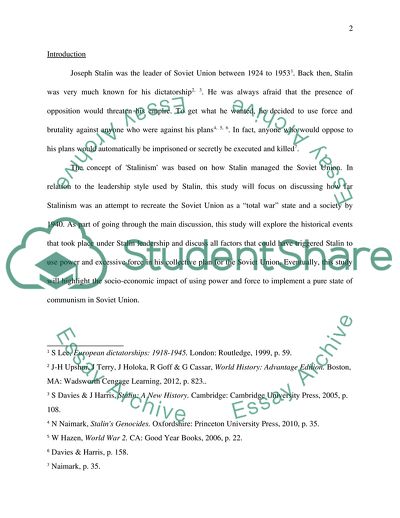Cite this document
(How Far was 'Stalinism' an Attempt to Recreate the Soviet Union as a 'Total War' State and Society by 1940 Essay Example | Topics and Well Written Essays - 2250 words, n.d.)
How Far was 'Stalinism' an Attempt to Recreate the Soviet Union as a 'Total War' State and Society by 1940 Essay Example | Topics and Well Written Essays - 2250 words. https://studentshare.org/history/1796356-how-far-was-stalinism-an-attempt-to-recreate-the-soviet-union-as-a-total-war-state-and-society-by-1940
How Far was 'Stalinism' an Attempt to Recreate the Soviet Union as a 'Total War' State and Society by 1940 Essay Example | Topics and Well Written Essays - 2250 words. https://studentshare.org/history/1796356-how-far-was-stalinism-an-attempt-to-recreate-the-soviet-union-as-a-total-war-state-and-society-by-1940
(How Far Was 'Stalinism' An Attempt to Recreate the Soviet Union As a 'Total War' State and Society by 1940 Essay Example | Topics and Well Written Essays - 2250 Words)
How Far Was 'Stalinism' An Attempt to Recreate the Soviet Union As a 'Total War' State and Society by 1940 Essay Example | Topics and Well Written Essays - 2250 Words. https://studentshare.org/history/1796356-how-far-was-stalinism-an-attempt-to-recreate-the-soviet-union-as-a-total-war-state-and-society-by-1940.
How Far Was 'Stalinism' An Attempt to Recreate the Soviet Union As a 'Total War' State and Society by 1940 Essay Example | Topics and Well Written Essays - 2250 Words. https://studentshare.org/history/1796356-how-far-was-stalinism-an-attempt-to-recreate-the-soviet-union-as-a-total-war-state-and-society-by-1940.
“How Far Was 'Stalinism' An Attempt to Recreate the Soviet Union As a 'Total War' State and Society by 1940 Essay Example | Topics and Well Written Essays - 2250 Words”. https://studentshare.org/history/1796356-how-far-was-stalinism-an-attempt-to-recreate-the-soviet-union-as-a-total-war-state-and-society-by-1940.


